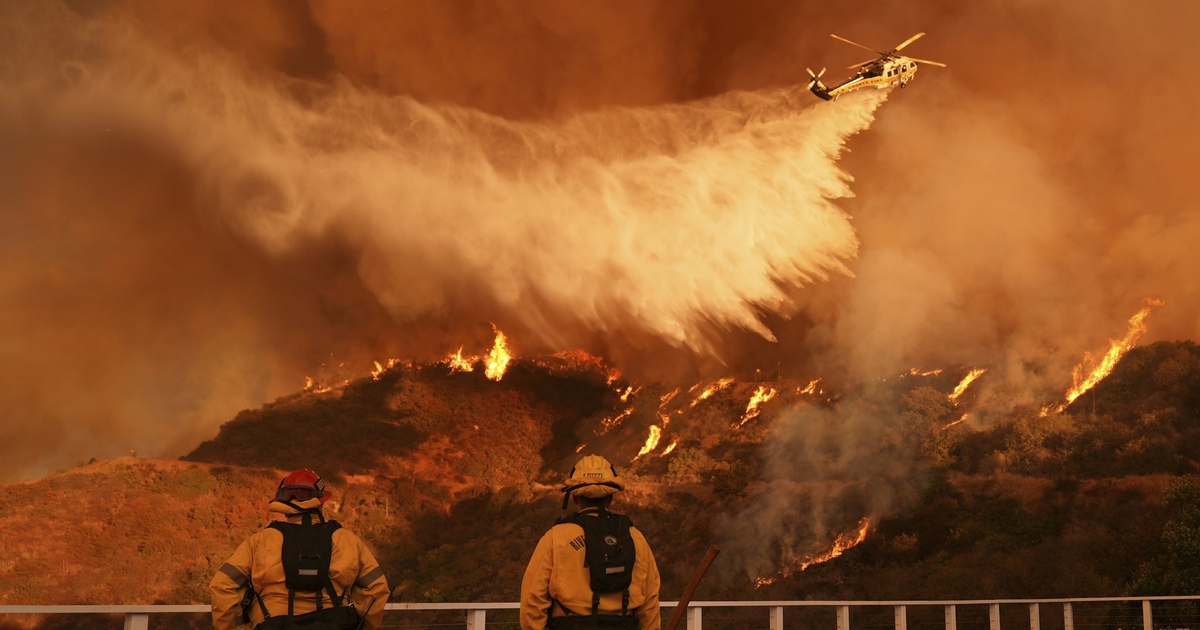Within a week, six fires spread across Los Angeles County at the same time, leaving 16 people dead and at least 13 missing, and about 12,000 structures burned or damaged, according to Reuters and AFP.
Firefighting helicopters were deployed in Mandeville Canyon on January 11
Efforts to prevent the fire from spreading
Yesterday (January 12), Reuters quoted an announcement from the Los Angeles County Coroner’s Office recording 5 deaths in the Palisades fire and 11 people died in the Eaton fire. Firefighting efforts shifted to focus on preventing the fire from spreading downwind to the J. Paul Getty Museum and the University of California at Los Angeles. In addition, authorities continue to issue evacuation warnings for new areas.
Before-after images show the fierce destruction of forest fires in the Palisades region (southern California)
As of last night (Vietnam time), the California Forestry and Fire Department (Cal Fire) announced that the Palisades, Eaton, Kenneth and Hurst fires had swept an area of about 160 km², an area larger than the City. San Francisco is in the same state. Of these, the Palisades and Eaton fires accounted for nearly 153 km². Representative Michael Traum of the California Office of Emergency Services said about 153,000 people in Los Angeles County were in the evacuation zone, with more than 700 people having to spend the night in temporary tents.
Fire crews from California and nine other states joined the firefighting effort, with support from colleagues from Canada and Mexico. A total of 1,354 fire trucks were deployed, along with 84 planes and helicopters, and more than 14,000 people responded to the scenes, according to Cal Fire. However, as of yesterday, they had only contained 11% of the Palisades fire and 11% of the Eaton fire. While the two largest fires, Palisades and Eaton, are still difficult to control, Cal Fire updated information that they have contained 90% of the Kenneth fire and 76% of the Hurst fire.
The risk is still great
AFP noted the fierce battle took place in Mandeville Canyon, home to actor Arnold Schwarzenegger as well as other celebrities and not far from the campus of the University of California in Los Angeles.

Mexican firefighters arrived in California on January 11
Despite the selfless efforts of firefighters, including aircraft and helicopter crews, the Palisades fire continued to spread and move eastward, threatening the J. Paul Getty Museum and others. The collection is priceless here, as well as spreading north into the densely populated San Fernando Valley.
“We were in a state of extreme nervous tension,” a resident named Sarah Cohen of Tarzana, a suburb of Los Angeles, shared with the Los Angeles Times. “Every time the plane released water, the situation got better, but then it continued to get worse,” she said.
Vietnamese people in California talk about ‘the most serious forest fire’
The US National Weather Service (NWS) warned that firefighting efforts face challenges with the return of Santa Ana winds in Los Angeles and Ventura Counties, bringing winds of nearly 50 km/h, gusting to 113 km/h. hours on January 13. “We are entering a period of severe fire weather that will last until January 15,” Reuters quoted NWS meteorologist Rose Schoenfeld as saying. “This development could promote fire spread faster as well as the risk of new fires appearing,” according to NWS.
In addition, Los Angeles County Sheriff Robert Luna warned that 166,000 people may have to evacuate if the situation worsens. As of yesterday, nearly 35,000 households and businesses in Los Angeles were still without power, according to Poweroutage.us.
Los Angeles opened an investigation
On January 12, AFP quoted Director of the Los Angeles Police Department Jim McDonnell as announcing that a task force to investigate the cause of the forest fire had been established, led by the Bureau of Alcohol, Tobacco, Firearms and Explosives.
“We will not miss a single clue,” Los Angeles County Sheriff Robert Luna emphasized, adding that authorities will hold accountable any individual or organization if found to be behind the mob. Palisades fire. The team of investigators will focus on finding clues to find out whether the forest fire disaster originated from natural causes or was an act of sabotage, or had another cause that could have been prevented.









